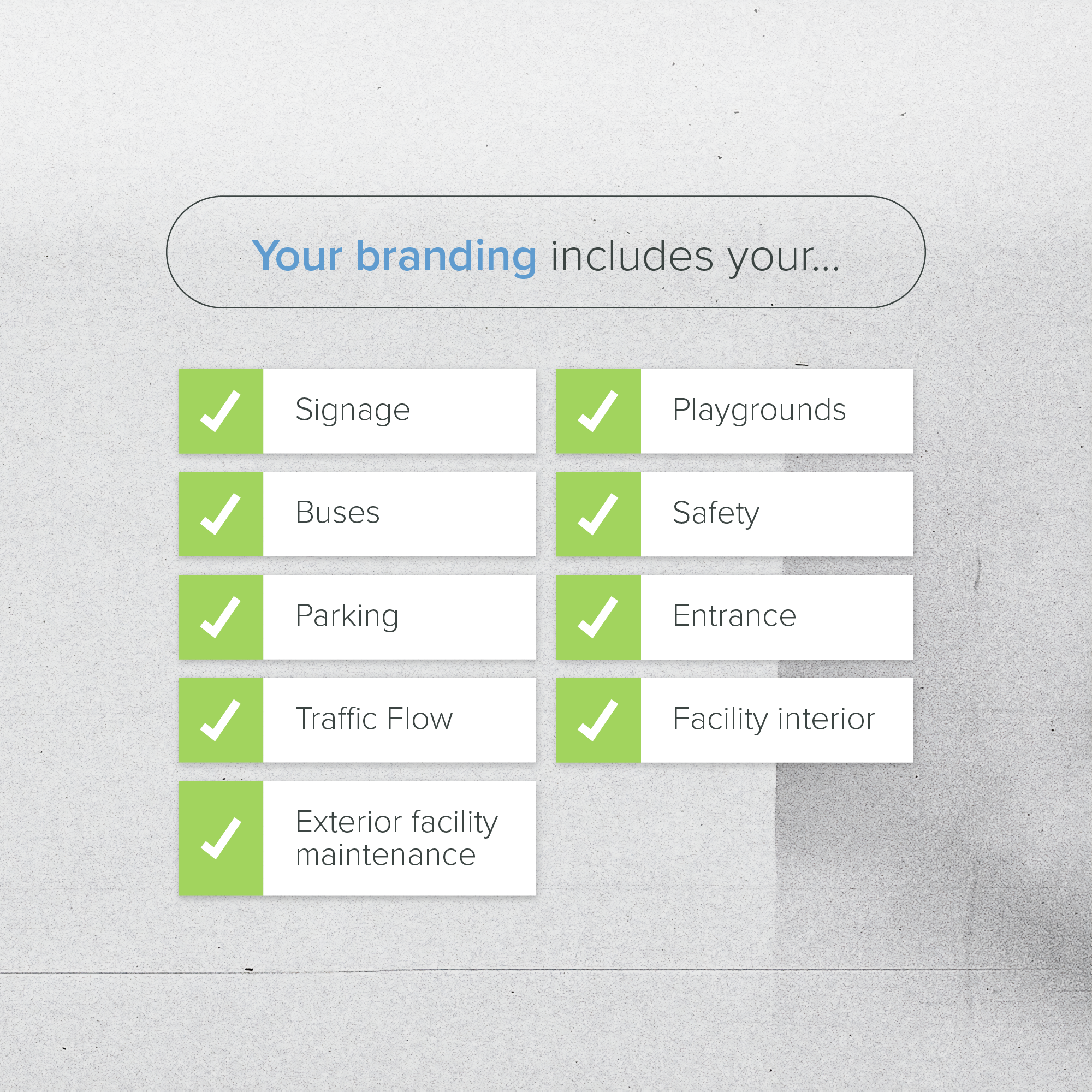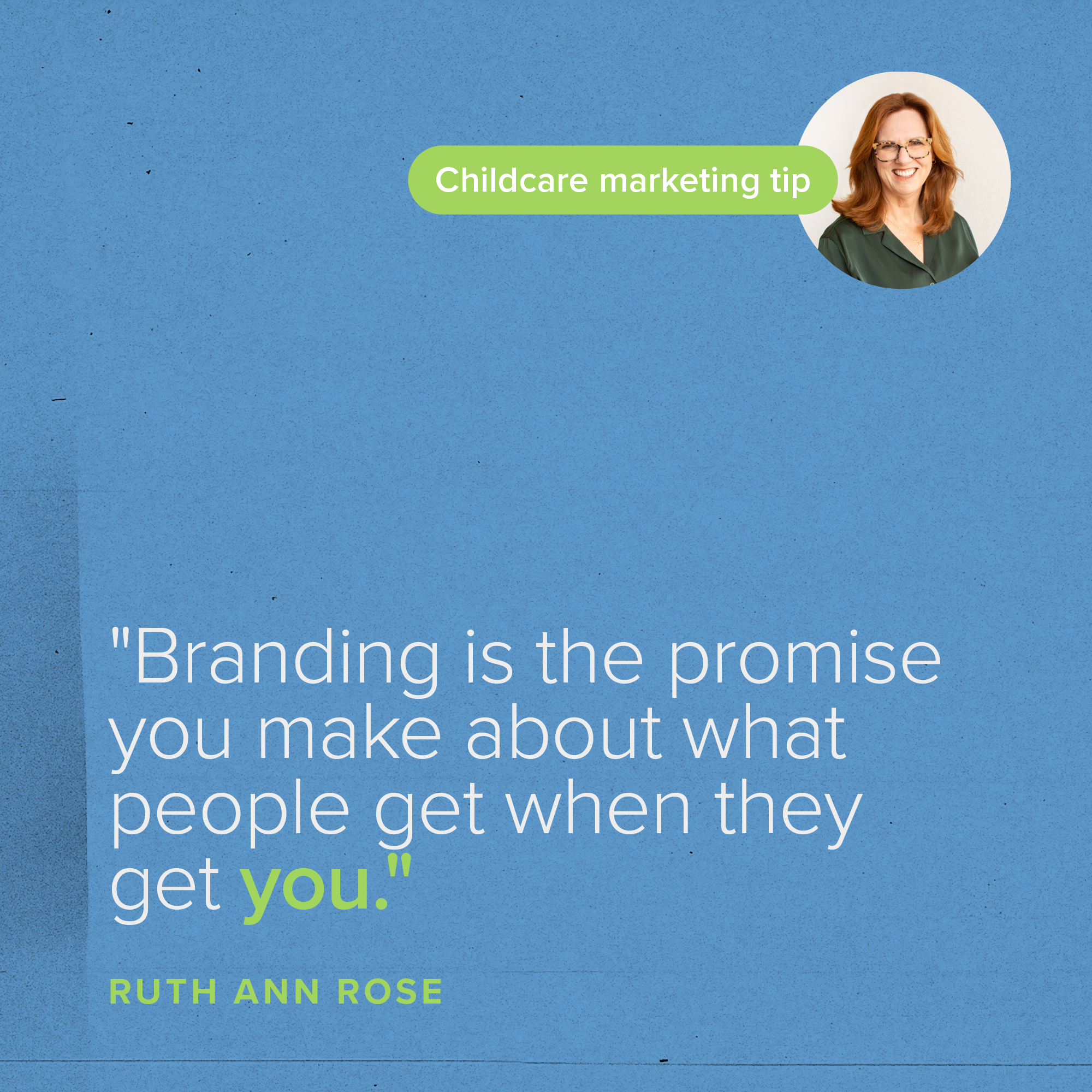When most people hear the word “branding,” they think of their logo, website, brochures, and business cards. But branding is so much more than that.
Branding is the promise you make about what people get when they get you. It’s composed of your staff, reputation, values, and more. Your brand includes and involves every experience between your company and other people.
Consistency with your target audiences is the key component of successful branding. Consider prospective families, existing families, employees, and even the children who attend your school. Remember that you interact with some of these audiences twice daily (at drop-off and pick-up). Any interruption in your brand’s perception calls into question every other aspect of your company.
By ensuring a consistent brand experience, you guide parents’ journeys from new prospects touring your facility into loyal brand ambassadors who leave rave reviews online. We’ll show you how.
Your Facilities Tell Your Story
Your facilities — how they look and smell, how you and your staff run them, and how your families interact with them — reflect and embody your brand. If you don’t pay close attention to the consistency of every aspect, you may not like the story your brand tells.
From the moment someone pulls into your parking lot, they start building a perception of who you are. Everything inside and outside your facility, including your equipment, contributes to that perception.
How to Elevate Branding in Your Facilities
Taking your branding to the next level is one way to distinguish your school from your competitors and maintain loyal families for years to come.
Here’s how.

Signage
Everyone knows the importance of signage, which includes your business name and logo. If there’s lighting on your sign, ensure it’s in working order.
Pro Tip: If and when you rebrand, replace or update all your signage, inside, outside, and online with new images and information. You’ll be surprised at how many places your logo and brand name appear when it’s time to refresh. Be thorough and meticulous.
Buses
Your buses are your school’s traveling billboards. In addition to transporting kids, they serve as mobile branding machines.
To get the most out of these mobile marketing tools, use a wrap featuring your school’s name, logo, phone number, website, and a QR code for easy access to online information and contact information.
Also, consider a design that’ll appeal to the kids you’ll be driving. Kids in fifth and sixth grade don’t want to get picked up by a daycare bus that looks like it’s for toddlers.
Remember, this older child audience is one of your target markets, too, and they’ll tell their parents where they’d like to go after school and during summer break. Don’t miss the opportunity to engage with them.
Your buses should always be in good condition aesthetically and mechanically. A filthy bus or one that’s broken down is not a way to advertise your school to passing parents.
Parking
Your parking lot is the first physical impression families get of your school. Every aspect matters. Be intentional with your parking spaces — they broadcast your priorities.
We recommend having designated parking for guests, expectant mothers, and tenured teachers.
- Guests — Having designated parking for guests demonstrates that they’re a priority and makes it easy for someone touring your facility to find a spot.
- Expectant mothers — This reserved parking shows that you prioritize families, including your existing ones.
- Tenured teachers — Specific parking spots for long-term staff demonstrate to parents that you value your teachers and they love your childcare center.
Traffic Flow
The traffic flow through your parking lot at drop-off and pick-up deserves your attention as well. You can improve on this major source of frustration for many schools by having lines clearly marked and rules communicated upon enrollment.
Most families are in a hurry during drop-off and pick-up times, so things must run smoothly. We’ve heard unfortunate stories of arguments and even physical altercations between parents when tempers flare over congested traffic or contested parking spots.
Incidents like this can damage your school’s reputation and impact many families’ experiences. Having a plan and rules in place for busy times of day is the best way to avoid such issues.
Exterior Facility Maintenance
Beyond branding, but in the same vein, maintaining your facility’s exterior creates a cohesive look and feel for your visitors. It allows you to communicate excellence in every detail. By the same token, every detail you ignore or neglect communicates that neglect to visitors, and they wonder if that neglect applies to their child’s care.
If you want people to consider your brand and business exceptional, you must attend to every detail as though it’s as essential as the care of children. When parents look at your landscaping and parking lot and see impeccable care, they expect their children will receive impeccable care as well.
However, if the landscaping is overgrown, the paint on the building is chipping, and cigarette butts litter the parking lot, they wonder if their children are receiving the care they deserve.
Make sure the building’s exterior, including the landscaping, parking lot, and playground areas, is always clean and tidy, especially before tours.
Playgrounds
Playground areas should be age-appropriate and clean. Never leave broken toys or equipment out. Keep grass and other landscaping trimmed, and remember to provide shade in the summer.
A popular concept is outdoor classrooms, art areas, or garden plots. If you provide areas like this, maintain them well and provide the necessary equipment and shade.
Safety
Your facility should make everyone feel safe and secure. Playgrounds need secure fencing. Parking lots require adequate lighting, especially in winter months when it’s likely dark at drop-off and pick-up times.
It’s wise to post signage that speaks to your security cameras and/or guards who patrol the parking lot. Such signage helps parents’ peace of mind and can help ward off thieves. Purse and computer bag theft are common in childcare parking lots — parents often leave vehicles unlocked, thinking they’ll only be gone for a few minutes.
Entrance
When you invite company over, you don’t wait to tidy up your house until after they arrive. The same should be true for your school’s entry.
Often, I’ll arrive at a school and find an overflowing garbage can, dead flowers in flower pots, a tattered door mat, or broken blinds in the front windows. These all contribute to my first impression of the school… and it isn’t good.
All those simple, little fixes would go far toward making a much better impression. Take the time and get ready (and stay ready) for company. You’ll be glad you did.
Facility Interior
The sights, smells, sounds, and staff inside your facility greet your visitors upon entering. Ideally, everything about your facility is pleasant and confirms a visitor’s decision to visit or enroll in your school as a good one.
Be aware of a guest’s experience as they enter your school. What does it look like? What do they smell? What sounds do they hear? How does the staff make them feel?
Consider all these aspects for a parent at drop-off, a parent at pick-up, and a new prospect coming for a tour. How does the front desk staff interact with a visiting parent versus a parent they see every day? How does a teacher act when they pass a parent in the hallway?
All these interactions and experiences are part of your brand.
When your staff members are at work, they represent your brand in every interaction and conversation. You must train your staff on how you want them to represent your brand. It’s also essential that you, your director, and your managers guide your staff through continued training and feedback to maintain your standard of excellence.

Tell Your Story
Your school has a story, and how you tell it is up to you. Ask yourself what message your facilities send to your audiences (remember, you have more than one).
Each week, walk through your school with fresh eyes. Notice the details — even the little ones — and the story they tell. Is it the one you want families to hear? If not, consider how you can change the narrative.
If you need help brainstorming, schedule a Power Hour with us. We’ll hone in on your story and discuss how to get your facility in order.
Subscribe
Sign up with your email address to receive news and updates.

